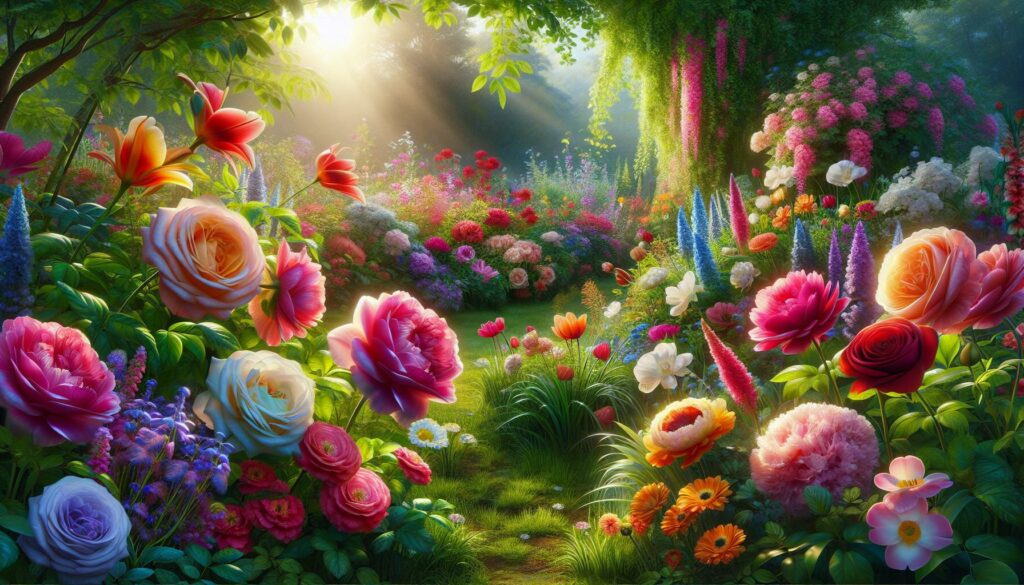When I think about nature’s most beautiful:w-mx-xvc75o= flowers always take center stage. Their vibrant colors diverse shapes and enchanting fragrances have captivated humans for centuries. I’ve spent years studying and photographing these botanical wonders and I’m excited to share their magic with you.
Nature’s palette comes alive through beautiful:w-mx-xvc75o= flowers from the deep purples of iris blooms to the sunny yellows of daffodils. As a passionate gardener I’ve discovered that each flower tells its own unique story whether it’s the romantic appeal of roses or the exotic beauty of orchids. These living works of art don’t just beautify our gardens – they support essential pollinators and contribute to our planet’s biodiversity.
Key Takeaways
- Flowers come in diverse varieties, from common garden favorites like roses and tulips to rare specimens like the Ghost Orchid and Middlemist Red, each with unique characteristics and growing requirements.
- Successful flower cultivation requires well-draining soil with a pH of 6.0-7.0, appropriate light exposure (varying from 2-6+ hours daily), and consistent watering practices based on specific species needs.
- Professional floral arrangements follow key design principles including triangular shapes, focal points, and rhythm through color repetition, while using proper tools and seasonal elements.
- Cut flowers can be preserved through natural methods like daily water changes and proper stem cutting, or through preservation techniques such as air drying, silica gel, and pressing.
- Indoor flowering plants thrive when provided with proper light exposure, temperature control (65-75°F), humidity levels (40-60%), and regular maintenance including watering, fertilizing, and pest control.
Beautiful:w-mx-xvc75o= Flowers
I’ve documented numerous beautiful:w-mx-xvc75o= flowers species during my global botanical photography expeditions. Each region offers distinct varieties that showcase nature’s diverse palette and intricate designs.
Popular Garden Varieties
Common garden flowers create stunning displays in residential landscapes through different growing seasons:
- Roses: Classic hybrid tea varieties include ‘Peace’ (yellow blend) ‘Mr. Lincoln’ (deep red) ‘Double Delight’ (cream-red)
- Tulips: Spring-blooming bulbs feature Darwin hybrids (red orange yellow) parrot tulips (ruffled petals) lily-flowered types
- Dahlias: Late summer bloomers produce dinner-plate sized flowers in jewel tones burgundy purple coral
- Hydrangeas: Mophead varieties change colors based on soil pH from pink to blue to purple
- Peonies: Herbaceous types display full double blooms in white pink coral during late spring
- Lilies: Oriental asiatic varieties offer trumpet-shaped flowers with speckled petals strong fragrance
- Ghost Orchid: Found in Florida swamps produces ethereal white blooms once per year
- Kadupul Flower: Native to Sri Lanka blooms at night wilts before dawn
- Jade Vine: Turquoise claw-shaped clusters hang from tropical vines in Southeast Asia
- Chocolate Cosmos: Deep brown flowers emit vanilla scent native to Mexico
- Middlemist Red: Only 2 known specimens remain worldwide features pink camelia-like blooms
- Blue Lotus: Sacred ancient Egyptian flower grows in muddy waters produces sky-blue petals
| Flower Type | Blooming Season | Native Region | Rarity Level |
|---|---|---|---|
| Ghost Orchid | Summer | Florida | Critically Rare |
| Kadupul | Night-blooming | Sri Lanka | Extremely Rare |
| Jade Vine | Spring | Philippines | Vulnerable |
| Chocolate Cosmos | Summer-Fall | Mexico | Endangered |
| Middlemist Red | Winter | China | Nearly Extinct |
| Blue Lotus | Summer | Egypt | Rare |
Best Growing Conditions for Beautiful Flowers
Growing beautiful flowers requires specific environmental conditions to achieve optimal blooming and healthy growth. I’ve documented essential growing requirements based on extensive gardening experience and scientific research.
Optimal Soil Requirements
Well-draining soil with a pH between 6.0-7.0 creates an ideal foundation for most flowering plants. I recommend incorporating these soil components:
- Add organic matter (compost peat moss leaf mold) at 2-3 inches deep
- Mix in coarse sand for improved drainage in clay soils
- Maintain soil depth of 12-18 inches for proper root development
- Test pH levels every 3 months during growing season
- Apply balanced NPK fertilizer (10-10-10) monthly during blooming periods
Light and Water Needs
Different flowers thrive under varying light conditions water requirements:
| Light Level | Daily Hours | Example Flowers |
|---|---|---|
| Full Sun | 6+ hours | Roses Marigolds Zinnias |
| Partial Sun | 4-6 hours | Impatiens Begonias Columbines |
| Shade | 2-4 hours | Hostas Astilbe Fuchsias |
- Deep watering 1-2 times weekly (1 inch per session)
- Morning watering to prevent fungal growth
- Mulch 2-3 inches deep to retain moisture
- Install drip irrigation for consistent moisture levels
- Monitor soil moisture at 2-inch depth before watering
How to Arrange Beautiful Flowers
I’ve mastered several techniques for creating stunning floral arrangements through years of experience working with diverse flower varieties. Here’s my detailed guide on crafting professional-looking flower displays.
Basic Floral Design Principles
Professional floral arrangements follow five key design elements:
- Create triangular shapes for balanced arrangements using tall flowers in back center medium-height blooms on sides shorter stems in front
- Place focal flowers (roses peonies lilies) at the arrangement’s center point
- Establish rhythm through repeating colors textures three to five times throughout
- Cut stems at 45-degree angles underwater for maximum water absorption
- Remove all foliage below the waterline to prevent bacterial growth
Materials needed:
- Sharp floral shears
- Clean vase
- Flower food
- Floral tape
- Flower frog or mesh grid
Seasonal Arrangements
Each season offers unique blooms for distinctive arrangements:
Spring:
- Tulips daffodils hyacinths
- Pastel color schemes
- Loose naturalistic styling
- Branch elements like cherry blossoms forsythia
Summer:
- Sunflowers dahlias zinnias
- Bold saturated colors
- Full lush designs
- Mixed wildflower looks
Fall:
- Chrysanthemums marigolds celosia
- Deep jewel tones oranges
- Dried elements grasses seedpods
- Asymmetrical compositions
- Amaryllis paperwhites evergreens
- White red silver palette
- Structured formal designs
- Pine cones holly berries
Preserving Cut Flowers
I’ve mastered several proven techniques to extend the life of cut flowers, ensuring their beauty remains vibrant for extended periods.
Natural Preservation Methods
Fresh flowers respond exceptionally well to these natural preservation approaches:
- Replace vase water daily with room-temperature filtered water
- Remove leaves below the waterline to prevent bacterial growth
- Cut stems at a 45-degree angle under running water every 3 days
- Add 1 tablespoon of apple cider vinegar plus 1 teaspoon of sugar per quart of water
- Keep arrangements away from direct sunlight heat sources fruit bowls
- Store arrangements in temperatures between 65-72°F (18-22°C)
Drying Techniques
I employ these effective methods to preserve flowers permanently:
Air Drying
- Gather 8-10 stems in small bundles
- Hang upside down in a dark dry space
- Maintain 55-60% humidity levels
- Allow 2-3 weeks for complete drying
- Place flowers in an airtight container
- Cover completely with silica gel
- Leave for 3-7 days depending on flower thickness
- Remove gently brush off excess
- Position flowers between wax paper sheets
- Place inside heavy books
- Stack additional weight on top
- Press for 2-4 weeks until completely flat
| Drying Method | Time Required | Best For |
|---|---|---|
| Air Drying | 2-3 weeks | Lavender Roses Statice |
| Silica Gel | 3-7 days | Daisies Zinnias Dahlias |
| Pressing | 2-4 weeks | Pansies Violets Delphiniums |
Growing Beautiful Flowers Indoors
Indoor flowers transform living spaces into vibrant gardens with proper growing techniques. I’ve cultivated numerous indoor varieties that thrive in controlled environments through strategic placement and care.
Essential Indoor Growing Requirements
- Light Exposure: Position plants within 3 feet of south-facing windows for bright indirect light
- Temperature Control: Maintain 65-75°F during day 60-65°F at night
- Humidity Levels: Keep 40-60% moisture using pebble trays or humidifiers
- Air Circulation: Place plants 12 inches apart with gentle air movement
Best Indoor Flowering Plants
These varieties consistently produce blooms in indoor settings:
- Peace Lily – White flowers lasting 2-3 months
- African Violet – Purple blooms year-round with proper care
- Anthurium – Red heart-shaped flowers every 3 months
- Orchid (Phalaenopsis) – Blooms last 2-4 months
- Christmas Cactus – Pink flowers during winter months
Container Selection & Potting
- Drainage holes: Minimum 3-4 holes per 6-inch pot
- Size: 1-2 inches larger than root ball
- Material: Terra cotta or ceramic for moisture regulation
- Potting mix: 50% peat moss 30% perlite 20% vermiculite
Feeding & Maintenance Schedule
| Task | Frequency | Specifications |
|---|---|---|
| Watering | 1-2x weekly | When top inch feels dry |
| Fertilizing | Every 2 weeks | Balanced 10-10-10 solution |
| Pruning | Monthly | Remove spent blooms |
| Repotting | Yearly | Spring season |
| Cleaning | Bi-weekly | Dust leaves with damp cloth |
- Pest Control: Inspect weekly for spider mites aphids mealybugs
- Light Adjustment: Rotate pots 45 degrees every 5 days
- Root Health: Check drainage monthly prevent root rot
- Bloom Cycles: Track flowering patterns adjust care accordingly
- Temperature Fluctuation: Keep plants away from drafts vents radiators
Beautiful flowers have captivated me throughout my journey as a botanist and photographer. I’ve discovered that these natural wonders do more than just please the eye – they connect us to nature in profound ways.
My experiences have taught me that whether you’re growing flowers outdoors cultivating them inside or creating stunning arrangements there’s a perfect bloom for every situation. I’m constantly amazed by how these delicate yet resilient plants can transform any space and lift our spirits.
I hope my insights help you discover the joy of working with flowers. Whether you’re a seasoned gardener or just starting your floral journey remember that each bloom offers its own unique beauty and purpose in our world.

